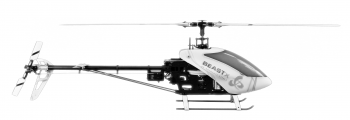Difference between revisions of "Manuals:MBPlusFblV5:Setupmenu J/de"
Shornstein (talk | contribs) (Created page with "{{TOC_MBPlusV5/de}} __TOC__ <br />") |
Shornstein (talk | contribs) (Created page with "Unter diesem Einstellpunkt wird der zur Verfügung stehenden zyklischen Steuerweg eingelernt. Betätige vorerst noch keinen Steuerknüppel. Richte stattdessen den Rotorkopf so...") |
||
| Line 3: | Line 3: | ||
<br /> | <br /> | ||
| − | + | Unter diesem Einstellpunkt wird der zur Verfügung stehenden zyklischen Steuerweg eingelernt. Betätige vorerst noch keinen | |
| + | Steuerknüppel. Richte stattdessen den Rotorkopf so aus, dass eines der Rotorblätter parallel zum Heckrohr/zur Längsachse | ||
| + | des Helikopters steht. Montiere dann eine Pitcheinstelllehre an diesem Rotorblatt.<br /> | ||
{| | {| | ||
|- | |- | ||
| Line 10: | Line 12: | ||
|}<br /> | |}<br /> | ||
<br /> | <br /> | ||
| − | + | Die Taumelscheibe muss neutral stehen und die Rotorblätter sollten 0° Pitchanstellwinkel haben. Falls das nicht der Fall ist, wiederhole die Einstellung der Servomitten unter Einstellpunkt H sowie die mechanische Einstellung. Schalte dann in die Messposition um und prüfe den Pitchwinkel. Dieser muss genau 6.0 Grad betragen (das Vorzeichen bzw. die Richtung ist dabei unwichtig). Erhöhe oder reduziere den Pitchwinkel, falls notwendig. Wenn die 6° eingestellt wurden, sollte die Status LED blau leuchten. Dies ist ein Zeichen, dass die Anlenkgeometrie des Helikopters optimal abgestimmt ist. Leuchtet die Status LED bei 6° hingegen in einer anderen Farbe oder überhaupt nicht so bedeutet dies, dass die Verhältnisse der Anlenkhebel am Helikopter nicht ideal sind und schon mit wenig Servoausschlag sehr große Anstellwinkel erreicht werden. Verwende in diesem Fall kürzere Servohebeln, anderen Kugelbolzen an der Taumelscheibe oder längeren Blatthalter-Anlenkhebeln. Andernfalls kann die ungünstige Geometrie dazu führen, dass der Regelkreis überreagiert. Schlechtes Einrastverhalten und übersensibles Flugverhalten können die Folge sein.<br /> | |
<br /> | <br /> | ||
{|cellpadding="4" cellspacing="0" border="1" | {|cellpadding="4" cellspacing="0" border="1" | ||
| − | | style="width:100px; text-align:left;" | '''Status-LED''' || style="text-align:center;" | ''' | + | | style="width:100px; text-align:left;" | '''Status-LED''' || style="text-align:center;" | '''Zyklischer Steuerweg''' |
|- | |- | ||
| − | | style="color:white; background-color:#CC66CC" | | + | | style="color:white; background-color:#CC66CC" | violett|| zu wenig |
|- | |- | ||
| − | |style="color:white; background-color:#FF3300" | | + | |style="color:white; background-color:#FF3300" | rot|| OK |
|- | |- | ||
| − | | style="color:white; background-color:#0066FF" | | + | | style="color:white; background-color:#0066FF" | blau || Perfekt! |
|}<br /> | |}<br /> | ||
<br /> | <br /> | ||
Revision as of 14:09, 2 January 2018
Unter diesem Einstellpunkt wird der zur Verfügung stehenden zyklischen Steuerweg eingelernt. Betätige vorerst noch keinen
Steuerknüppel. Richte stattdessen den Rotorkopf so aus, dass eines der Rotorblätter parallel zum Heckrohr/zur Längsachse
des Helikopters steht. Montiere dann eine Pitcheinstelllehre an diesem Rotorblatt.

|

|
Die Taumelscheibe muss neutral stehen und die Rotorblätter sollten 0° Pitchanstellwinkel haben. Falls das nicht der Fall ist, wiederhole die Einstellung der Servomitten unter Einstellpunkt H sowie die mechanische Einstellung. Schalte dann in die Messposition um und prüfe den Pitchwinkel. Dieser muss genau 6.0 Grad betragen (das Vorzeichen bzw. die Richtung ist dabei unwichtig). Erhöhe oder reduziere den Pitchwinkel, falls notwendig. Wenn die 6° eingestellt wurden, sollte die Status LED blau leuchten. Dies ist ein Zeichen, dass die Anlenkgeometrie des Helikopters optimal abgestimmt ist. Leuchtet die Status LED bei 6° hingegen in einer anderen Farbe oder überhaupt nicht so bedeutet dies, dass die Verhältnisse der Anlenkhebel am Helikopter nicht ideal sind und schon mit wenig Servoausschlag sehr große Anstellwinkel erreicht werden. Verwende in diesem Fall kürzere Servohebeln, anderen Kugelbolzen an der Taumelscheibe oder längeren Blatthalter-Anlenkhebeln. Andernfalls kann die ungünstige Geometrie dazu führen, dass der Regelkreis überreagiert. Schlechtes Einrastverhalten und übersensibles Flugverhalten können die Folge sein.
| Status-LED | Zyklischer Steuerweg |
| violett | zu wenig |
| rot | OK |
| blau | Perfekt! |
Adjustment on the device
Initially the Status LED will be off, the swashplate will be leveled and rotorblades will have 0 degrees of pitch. Attach your pitch gauge at the rotorblade or blade grip, calibrate it to 0 degrees and then tap the aileron stick once. This will move the rotorblade into measuring position. Now check the pitch gauge, we want to see exactly +-6.0 degrees. By rudder stick input you can increase/decrease the amount of pitch (left = decrease, right = increase). You can switch back and forth between measure and zero position as often as you like. When done click the button to proceed to the next menu point.
Setup with StudioX
To activate the cyclic throw adjustments click the Adjust button in the corresponding table row (when using the Wizard function this will be done automatically when you click the Next button after adjusting Menu Point J).
Initially the swashplate will be leveled and rotorblades will have 0 degrees of pitch. Attach your pitch gauge at the rotorblade or blade grip, calibrate it to 0 degrees and then click the Measure button. This will move the rotorblade into measuring position. Now check the pitch gauge, we want to see exactly +-6.0 degrees. Increase/decrease the value in the box until the pitch is adjusted correctly. Then click the Save button or Next button (when using the Wizard function) and proceed with the setup.
Setup with StudioXm
Initially the swashplate will be leveled and rotorblades will have 0 degrees of pitch when the cyclic throw adjustment screen opens. Attach your pitch gauge at the rotorblade or blade grip, calibrate it to 0 degrees and then click the Measure button. This will move the rotorblade into measuring position. Now check the pitch gauge, we want to see exactly +-6.0 degrees. Increase/decrease the throw value with the + and - buttons or the dial until the pitch is adjusted correctly.
